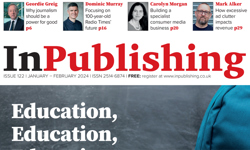
There’s a lot of transatlantic travel at the moment. Hearst and Condé Nast continue to refocus on their domestic market with a far-reaching “USA-first” shift in their content creation. Future and Dennis see real potential for their business models across the pond. WHSmith is still gambling its whole future on its Travel division, which is massively dependent on the USA, and on the country growing and opening up quickly. And the Waterstones’ approach is still shaping Barnes & Noble. Whilst the past has been littered with disastrous Brit forays into America – WHSmith being one of them, not that long ago – the USA is now receiving more attention, as Chinese influence grows.
To put things into perspective, the USA is still by far the world’s largest market for media products and services, despite the rapid growth of China and India. In simple population terms, the UK is around 20% the size of America. Yet our Newspaper & Consumer Magazine industry is only 12% of the US scale in revenue terms and B2B stands at an even lower 9%. Whilst the GDP growth rate of the USA may not match that of China and India, it is still twice that of the UK.
The latest mediafutures project digs deeply into comparing the performance and attitudes of over 170 UK media companies against 154 US peers.
- Turnover: UK looks weaker than USA. The 2020 revenue dip was worse in the UK than in the USA, both in terms of the number of companies showing a drop in turnover and the average rate of fall: -9% in the UK versus -6% in USA. The 2021 recovery is a more mixed picture. More UK companies are predicting growth this year, but the average rate of growth is much weaker: +2% as opposed to +7% in USA.
- Profit margins: UK running tighter, but underinvesting in the future? The UK is stronger, both in terms of the actual profit margins now (8.2% versus 7.6%), but also in increasing them this year. Yet as the marketing budget metrics show, the USA looks to be investing more in their brands and for the future.
- Headcount: USA started the staff cull earlier. Whilst still being very tough in the USA, the number of UK publishers still cutting headcount is significantly higher. The USA looks to have made swifter cuts in 2019 and the first half of 2020. The UK is playing catch-up.
- Marketing budgets: USA investing more. The USA is still investing significantly more in research, marketing and NPD (7.2% of turnover) than their UK counterparts (5.8%). And the gap is widening, as 40% of US companies are increasing their budgets as opposed to only 26% in Europe.
- Digital revenue skew: USA much more advanced, but UK catching up. The US media business is currently generating a much higher percentage of total revenues from digital products & services (37%) than is the case in the UK (28%). Yet the gap is closing, as the Digital Shift accelerates.
- Advertising revenue dependence: US ad-skewed model persists. The USA has always had a publishing model that relies much more on advertisers & sponsors than is the case in the UK. Both markets are reducing their ad dependence, but the USA is doing so at a much slower rate. This is an area where a number of UK companies see the chance to import into the USA a more radical business model. Comparing Future and Meredith who respectively picked up the old UK and US Time portfolios shows that Future has made a much better job of it than Meredith. Watching them now compete much more directly in America will be fascinating.
- Print skew: Print revenues dropping faster, but still very important. The rate of shift out of print is very similar in both regions, but from a higher current print dependence in UK (52%) than in the USA (47%).
- Confidence levels: broadly similar, but US confidence coming back faster. The confidence levels in both regions are very similar and not as low as might have been expected given the events of 2020. Yet confidence is seeping back more quickly in the USA.
What is clear is that the US publishing business remains, in the main, totally uninterested in anything outside their domestic market – the exact opposite of UK companies, who see “geo-cloning” as a key element of their revenue diversification programme. International activity is already important to the UK media business. For B2B, it accounts for an average 26% of total turnover in comparison to only 9% for Consumer Media. Both are predicted to grow over the next two years.
However, there has been a real change in mindset over the last few surveys. Go back four years and international expansion was high on the priority list of many UK media companies. Then the enthusiasm began to cool as people realised that geo-cloning is not as straightforward as it appears on first sight. The current survey shows that going international is now edging back up the to-do list.
mediafutures highlights three big issues. Firstly, where to go in search of growth? Over the last few years, there has been a big shift for many Western European media companies out of Russia and Eastern Europe. Meanwhile, China is not opening up as many had hoped. So, the focus has actually shifted from the East to the West.
Secondly, the cultural differences between countries are often underestimated and can lie hidden just beneath the surface.
Thirdly, going international raises all kinds of organisational and structural issues. Should the organisation be structured vertically by territory or horizontally by common processes? The obvious answer is a bit of both, but that can end up in a messy fudge.
Yet despite all the caveats and complexities, going international is still a key opportunity, with the global pandemic opening up all kinds of unexpected gaps and alliances.
So, do “Go West, young man!”
Whilst the GDP growth rate of the USA may not match that of China and India, it is still twice that of the UK.
About mediafutures international: mediafutures is an annual benchmarking survey of the industry undertaken by Wessenden Marketing in partnership with InPublishing. In 2020, mediafutures went international with Colin Morrison’s Flashes & Flames and Access Intelligence in the USA as two new partners.
This article was first published in InPublishing magazine. If you would like to be added to the free mailing list, please register here.










